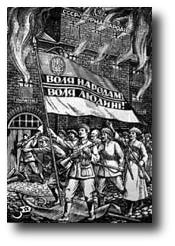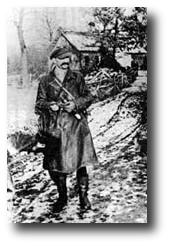![[LITOPYS UPA: Chronicle of the Ukrainian Insurgent Army]](/upa/images/litopys.jpg)
SERIES 1
VOLUME 1
![[LITOPYS UPA: Chronicle of the Ukrainian Insurgent Army]](/upa/images/litopys.jpg)

 The region of Volyn' (Volhynia) encompasses the contemporary provinces
(oblasti ) of Volyn', Rivne, Zhytomyr, the northern parts of
Khmel'nytskyi and Ternopil provinces and the Ukrainian ethnographic
districts of southern Belorussian SSR. The south of Volyn' is
predominantly an agricultural area with some forested and swampland
regions, while in its northern parts lie the numerous bogs, swamps and
heaths of Polissya (Polese) - the perfect terrain for guerilla
warfare. This area witnessed in 1942-1943 the birth of the Ukrayins'ka
Povstans'ka Armiya or UPA (the Ukrainian Insurgent Army), whose
soldiers took up arms against both the German and the Soviet power
with an aim of establishing an independent Ukrainian state. In time
the UPA's activities spread to other parts of Ukraine. Peculiar to the
underground movement was the designation of Volyn' as the PZUZ or
Pivnichno-zakhidni ukrains'ki zemli (the North-Western Region of
Ukraine).
The region of Volyn' (Volhynia) encompasses the contemporary provinces
(oblasti ) of Volyn', Rivne, Zhytomyr, the northern parts of
Khmel'nytskyi and Ternopil provinces and the Ukrainian ethnographic
districts of southern Belorussian SSR. The south of Volyn' is
predominantly an agricultural area with some forested and swampland
regions, while in its northern parts lie the numerous bogs, swamps and
heaths of Polissya (Polese) - the perfect terrain for guerilla
warfare. This area witnessed in 1942-1943 the birth of the Ukrayins'ka
Povstans'ka Armiya or UPA (the Ukrainian Insurgent Army), whose
soldiers took up arms against both the German and the Soviet power
with an aim of establishing an independent Ukrainian state. In time
the UPA's activities spread to other parts of Ukraine. Peculiar to the
underground movement was the designation of Volyn' as the PZUZ or
Pivnichno-zakhidni ukrains'ki zemli (the North-Western Region of
Ukraine).
This first issue of the "Litopys UPA" deals with the activities of UPA in Volyn' and Polissya during the German occupation. The materials collected here give a general characteristic of the situation in these regions and show the organization of the UPA and its military and political activity. (The materials dealing purely with the military activity of the UPA will be published in future collections). This volume, however, includes several general orders of the Volynian Command of the UPA and of the UPA Headquarters.
The volume also contains UPA publications pertaining to the First Conference of the Enslaved Peoples of Eastern Europe and Asia, and UPA leaflets directed at various ethnic units of the German army.
The volume begins with the article by Col. M. Omeliusik entitled "The UPA in Volyn' in 1943" which is a serious analysis of the UPA activity in that region. The author who was the Chief of the Operational Section of the Volynian Command of the UPA speaks from personal experience about the successes and failures of the UPA. His article is also based on a number of later publications about the UPA on that territory which complement his personal account. This article is the only item in the book written by an emigre.
The article by H. Levenko "An Historical Outline of the UPA Struggle" written in Ukraine in 1944 is similar thematically. The "Outline" as is clear from the introduction was written by a member of the OUN - Orhanizatsia Ukrains'kych Nationalistiv - (Organization of Ukrainian Nationalists), who took part in the UPA. It represents probably one of the first attempts to provide the origins and history of the UPA under German occupation.
The article by I. M. Kovalenko "The Goals and Methods of the German Imperialist Policy in the Occupied Regions" offers a thorough critical analysis of German imperialistic policy. It was written in the spring of 1943 and was republished several times as educational material for the UPA forces and the underground as a whole.
 The articles which are grouped in the section
"Military - educational, political and informational materials"
represent examples of UPA publications which have appeared in
1943. These publications show the level of professionalism which
existed at the initial period of UPA's organizational activities and
the sources of historical traditions sought by their authors for the
UPA. Here the analyst will find two versions of a document which is
known under its later title, namely, 'What is the UPA Fighting
For?". The first version of this document under the title "What is the
Revolutionary-Liberationist UPA Fighting For?", was undersigned by the
OUN Leadership and printed as a leaflet in Ukrainian and Russian. The
text of this leaflet was subsequently shortened, revised and re-edited
by the Political Section of the UPA Supreme Command, and released
under the title "What is the UPA Fighting For?", this time undersigned
"Ukrainian Insurgent Army". This document represents a political credo
of the UPA. Worthy of interest are the changes which the editors found
necessary to introduce into the original version of the document.
The articles which are grouped in the section
"Military - educational, political and informational materials"
represent examples of UPA publications which have appeared in
1943. These publications show the level of professionalism which
existed at the initial period of UPA's organizational activities and
the sources of historical traditions sought by their authors for the
UPA. Here the analyst will find two versions of a document which is
known under its later title, namely, 'What is the UPA Fighting
For?". The first version of this document under the title "What is the
Revolutionary-Liberationist UPA Fighting For?", was undersigned by the
OUN Leadership and printed as a leaflet in Ukrainian and Russian. The
text of this leaflet was subsequently shortened, revised and re-edited
by the Political Section of the UPA Supreme Command, and released
under the title "What is the UPA Fighting For?", this time undersigned
"Ukrainian Insurgent Army". This document represents a political credo
of the UPA. Worthy of interest are the changes which the editors found
necessary to introduce into the original version of the document.
The Orders of the UPA Command in the Volyn' Region which was at that time the Supreme Command of all UPA, throw light on various aspects of military administration. "Order to the UPA Forces" of 27 August 1943 establishes a system of ranks and regulates certain personal matters ( subsequently this order was superseded by the order of the UPA Supreme Command in 1944, which introduced changes into the nomenclature of military ranks). Order #8 of 30 August, deals with the organization of self-defence units among the population. Order #9 of 1 September 1943 regulates reporting channels of the UPA Commanders, orders the stock-taking of the radiotechnical material, and deals with the organization of cavalry units. Other orders focus on the following: preservation of military secrets ( #10 of 3 September 1943); organization of a village's self-defence and plans of action against German punitive expeditions ( #11 of 4 September 1943); organization of recruitment of the candidates to the second officers school and to other training schools ( #12 of 4 September 1944); granting of non-commissioned and commissioned officer ranks to UPA soldiers ( #13 of 4 September 1943); and the organization of contacts and cooperation with the non-German military units in the German army (#17 of 28 October 1943).
A number of orders issued by the Chief of Political Staff of the UPA Group "Zahrava" deal with the organization of schools in the area of its operations. These are quite typical examples of the UPA activities in this sphere.
The volume also contains a number of Orders of the UPA Supreme Command of January 1944 because they are directly relevant to UPA activities in Volyn'. Here we find the "Instruction of the Work of Military Command Headquarters" which represents an appendix to Order #1/1944 (the copy of the Order itself is not available) which outlines the duties of command staffs. Order #2/1944 deals with promotions and staff changes. Order #3/1944 regulates military honours and decorations and establishes military insignia for commissioned and non-commissioned officers.A large number of documents and photographs in this volume were made available by the Archives of ZP UHVR or Zakordonne Predstavnytstvo Ukrains'koi Holovnoyi Vyzvol'noyi Rady (Foreign Representation of the Supreme Ukrainian Liberation Council). These and other sources are properly identified by footnotes.
The compilers would like to express their gratitude to all institutions and individuals who helped with the publication of this first volume of the "Litopys UPA".
A name and geographical index as well as explanatory notes are located at the end of the volume.
Compilers of the First Volume of the "Litopys UPA"